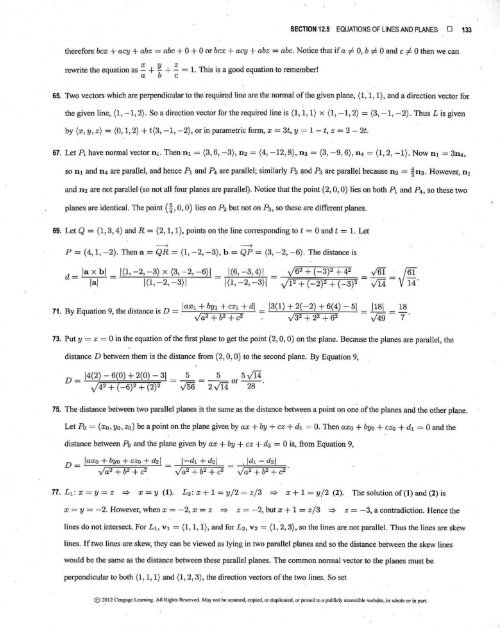Exercicios resolvidos James Stewart vol. 2 7ª ed - ingles
Create successful ePaper yourself
Turn your PDF publications into a flip-book with our unique Google optimized e-Paper software.
SECTION 12.5 EQUATIONS OF LINES AND PLANES 0 133<br />
therefore bcx + aetJ + abz = abc + 0 + 0 or bcx + acy + abz = abc. Notice that if a ol 0, b ol 0 and c ol 0 then we can<br />
' . X '1j Z 1 Th' . d . be I<br />
rewnte the equat1on as - + - + - = . ts 1s a goo equat1on to remem r.<br />
a b c<br />
65. Two vectors which are perpendicular to the·requir<strong>ed</strong> line are the normal of the given plane, (1, 1, 1), and a direction vector for<br />
the given line, (1, - 1, 2). So a direction vector for the requir<strong>ed</strong> line is (1, 1, 1} x (1, -1, 2} = (3, - 1, -2}. Thus L is given<br />
by (x, y, z} = (0, 1, 2} + t(3, -1, - 2}, or in parametric form, x = 3t, y = 1- t, z = 2- 2t.<br />
67. Let Pi have normal vector D i. Then n1 = (3, 6, -3}, n 2 = (4, -12, 8), n a = (3, -9, 6), ll4 = (1, 2, - 1}. Now n 1 = 3D4,<br />
so n1 and n4 are parallel, and hence P1 and P4 are parallel; similarly P 2 and P3 are parallel because n2 = ! n 3. However, n 1<br />
and n 2 are not parallel (so not all four planes are parallel). Notice that the point (2, 0, 0) lies on both P 1 and P 4 , so these two<br />
planes are identical. The point ( ~ , 0, 0) lies on P2 but not on P3, so these are different planes.<br />
69. Let Q = (1, 3, 4) and R = (2, 1, 1), points on the line corresponding to t = 0 and t = 1. Let<br />
. .<br />
---> --+<br />
P = ( 4, 1, - 2). Then a = QR = (1, - 2, -3), b = QP = (3, - 2, - 6) . The distance is<br />
d = Ia x bl = 1(1, -2,-3} x (3,-2,-6}/ = 1(6, - 3,4)1 = J6 2 + (-3)2 + 42 = J6I = {61<br />
/al 1(1, -2, -3}/ 1(1, - 2, - 3}1 JP+(- 2)2 + (-3)2 v'I4 V14'<br />
1 BE<br />
. tl<br />
9<br />
d'ta . D iax1+by1+cz1 +d/ /3(1) +2(- 2)+6(4)-5/ /181 18<br />
7 . y quat1on , 1e IS nee IS = = = r.n = - .<br />
Ja2+b2+ c2 . J 32 + 22 + 62 v49 7<br />
73. Put y = z = 0 in the equation of the first plane to get the point (2, 0, 0) on the plane. Because the planes are parallel, the<br />
distance D between them is the distance from (2, 0, 0) to the second plane. By Equation 9,<br />
D = /4(2) - 6(0) + 2(0) - 31 = _ 5_ = _5_ or 5 VT4.<br />
J42 + ( - 6)2 + (2)2 V56 2 VI4 28<br />
75. The distance between two parallel planes is the same as the distance between a point on on~ ofilie planes and the oilier plane.<br />
Let Po = (xo, yo, zo) be a point on the plane given by ax+ by + cz + dt = 0. Then axo + byo + czo + d 1 = 0 and the<br />
distance between Po and ilie plane given by ax + by + cz + d2 = 0 is, from Equation 9,<br />
D = /ax o + byo + czo + d2/ = /-dl + d2 / , /d1 - d2 /<br />
Ja2 +b2+c2 Ja2 + b2+ c2 Ja2+ b2+c2<br />
77. £ 1: x = y = z =? x = y (1). £2: x + 1 = y/2 = z/3 =? x + 1 = y/2 (2). The solution of (l ) and (2) is<br />
x = y = - 2. However, when x = -2, x = z =? z = - 2, but x + 1 = z/3 =? z = - 3, a contradiction. Hence the<br />
lines do not intersect. For L1. v1 = (1, 1, 1), and for L2, v2 = (1, 2, 3}, so the lines are not parallel. Thus ilie lines are skew<br />
lines. If two lines are skew, they can be view<strong>ed</strong> as lying in two parallel planes and so ilie distance between the skew lines<br />
would be the same as the distance between these parallel planes. The common normal vector to the planes must be<br />
perpendicular to boili (1, 1, 1) and (1, 2, 3), the direction vectors of the two lines. So set<br />
® 2~ 12 Ccogogc Lc;uning.. All Rights R.esen·cd. Mny not be SC4M<strong>ed</strong>, copi<strong>ed</strong>, or duplicat<strong>ed</strong>, or post<strong>ed</strong> to a publicly accessible website, in whole or in pan.


